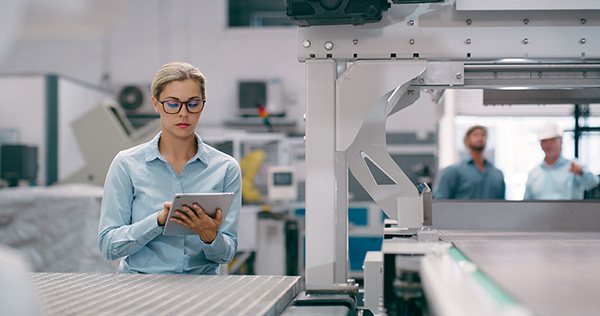Agentic AI provides manufacturers with real-time guidance, context, and decisions, turning scattered data into smart and autonomous action.
Artificial intelligence tools have been adopted widely across a variety of industries, from finance to retail. These tools have helped to reshape those industries for the better through increased efficiency and by freeing up employees for more impactful work. However, the manufacturing industry has been slower to embrace AI.
According to Gartner Research, for manufacturers to achieve scalable growth, they have to shift from an operator mindset to an enabler mindset by prioritizing strategic objectives and by leveraging AI and generative AI to drive progress. For example, Gartner cited Data Electronics, which used accelerated AI training models to reduce an automated inspection process from two days to just 10 minutes with 90 percent accuracy.
Despite these kinds of benefits, many manufacturers remain hesitant, often citing high costs, cybersecurity concerns, and the lack of simple plug-and-play solutions as their barriers to adoption, manufacturers who do not adopt AI may struggle with fragmented data, outdated legacy systems and siloed operations.
But thanks to the latest advances in agentic AI, manufacturers have new options to integrate tools that will revolutionize their operations. Unlike traditional AI tools, which are typically rules-based and task-specific, agentic AI is able to reason, to learn from context and act autonomously within a complex manufacturing environment, making it a more accessible and impactful solution for those manufacturers who are looking to modernize.
With agentic AI, manufacturers now have the opportunity to move away from outdated processes and deploy intelligent agents that enhance operations.
Most manufacturers still struggle to integrate AI in a meaningful way. The problem is not due to the lack of data. The problem is because the data is scattered, disjointed and out of context. In addition, the data often also comes from different databases that do not relate very well to each other in most cases.
Some companies are taking a proactive approach and are trying to unify their data by pulling it into centralized platforms, and while that is a good first step, organizations can save a significant amount of time through contextualizing that data. That is where agentic AI really comes in.
Agentic AI can interpret real-time data and make informed decisions. It can interact with users in natural language with what is often referred to as a contextualizer tool — essentially serving as a cognitive backbone. Once a contextualizer is in play, an agent can analyze that data and save a plant employee time.
Agentic AI systems receive “training” in a specific environment, such as a factory environment. And with these types of systems in place, it allows humans to move from being hands-on to having higher-value oversight. The systems can augment decisions and automate certain tasks such as creating a ticket, checking inventory, finding a needed part or even scheduling maintenance.
Agentic AI systems are also capable of understanding user questions and plant conditions. Combined with a visual interface and live data feeds, these systems can deliver real-time insights without the delays of manual evaluation.

Among the many ways agentic AI can improve and enhance smart manufacturing, troubleshooting stands out as a high-impact and attractive application. Take this common scenario for example: A machine or piece of equipment on the factory floor stops working. Traditionally, the process of figuring out the issue would be to verify each machine and then locate the correct resolution to the issue, which would take time. Also, the process might not be consistent and would look different each time that issue came up, or the issue might be unnecessarily escalated. But with an agentic AI system, the user can just ask the assistant, “is this machine working or not?” The user can also collect other data, including the current temperature and status of the unit.
The assistant can provide reliable data and guide the user through the proper procedure to address the equipment issue, such as overheating or motor failure, as opposed to having the user dig through manuals for the answer. Another task the agent can do to improve the manufacturing floor is take the initiative and connect the dots and the information so that the search period is shortened. For example, if the user knows an alert has been triggered on the shop floor, but if the agent also knows how to resolve the issue. That type of autonomy is a huge time saver and boosts productivity.
The agent will provide those actionable steps in real time. Unlike traditional automation, agentic AI augments the capabilities of humans as opposed to trying to simply replace them. The systems learn from context, adapt to different conditions and understand natural language.
So, while it doesn’t replace the human element, it provides the human with better situational awareness and helps make the shop floor more productive.
In order for agentic AI to be good at understanding the intent behind user queries, the agent has to be made aware of all those things that might matter and keep it in a central hub. That includes making it aware of machine specifications, user manuals and safety procedures.
Manufacturers are starting to embrace these tools, but not yet at the level they should be, often due to security concerns. Manufacturing faces a set of cybersecurity challenges from a vulnerability perspective and is in the early stages of building comprehensive strategies to manage cyber threats effectively, which leaves them more vulnerable as they often have outdated legacy systems with limited security measures.
This is where agentic AI will be helpful because it can operate within and around legacy systems and doesn’t require a full infrastructure overhaul. This technology works with existing setups, and can even identify potential vulnerabilities in real time. The systems can also set priorities and guide compliance with safety or security protocols by accessing critical security data.
The potential of agentic AI in manufacturing goes beyond simple troubleshooting. Having agentic AI isn’t about just speeding up decision making. It is about having something that can improve the quality of those decisions because it has all the relevant data it needs to make that decision, in real time.
If you, for example, think of how personal assistants in our homes currently handle a variety of tasks. They can handle everything from playing music and adjusting the thermostat to turning on the TV or checking the weather. In the morning, you might quickly ask for the forecast and decide what to wear based on that information that you receive. The same kind of intuitive, contextual assistance is coming to manufacturing.
Agentic AI anticipates what is needed, supports smarter decision-making and enhances human capabilities rather than just automating processes. It frees workers from repetitive or reactive tasks so they can focus on higher-value work.
Agentic AI can support everything from scheduling and quality control to sustainability monitoring and workforce training, and, as these systems evolve and improve, they will move beyond being digital assistants. They will begin to function more like trusted advisors that proactively suggest operational improvements and more. Agentic AI offers a practical path forward — a path that improves productivity without disrupting plant operations.

About the Author:
Leo Vieira serves as the digital industry director at Stefanini Group. He is focused on building strong partnerships with clients to drive operational efficiency and cost optimization through innovative and high-impact solutions. With a background in mechatronics engineering and an MBA in project management, he has spent his career holding diverse roles ranging from consulting to large-scale project delivery.
In this episode, I sat down with Beejan Giga, Director | Partner and Caleb Emerson, Senior Results Manager at Carpedia International. We discussed the insights behind their recent Industry Today article, “Thinking Three Moves Ahead” and together we explored how manufacturers can plan more strategically, align with their suppliers, and build the operational discipline needed to support intentional, sustainable growth. It was a conversation packed with practical perspectives on navigating a fast-changing industry landscape.